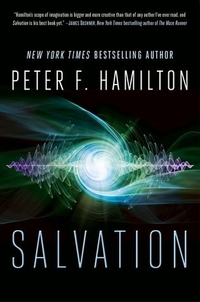Salvation by Peter F. Hamilton
 Saturday, November 2, 2019 at 9:52PM
Saturday, November 2, 2019 at 9:52PM 
Published by Del Rey on September 4, 2018
There are so many moving parts in Salvation it is difficult to hold them all in memory, and this is only the first book in a trilogy. Part of the story takes place on Juloss in the distant future, a planet that humans have inhabited and mostly abandoned. Dellian and Yirella are training for combat against an enemy that destroys all life in its path. They are members of the first generation of binary humans to be born on the planet. Most humans have fled the galaxy on generation ships, making Juloss the last known planetary home to free humans. The plan is to biomodify the humans who stay behind so they can be sent off on a battleship to fight the enemy.
Juloss has benefitted from technology supplied by a Neána insertion ship, including pet-like biologics called muncs that help them fight. The humans on Juloss believe themselves to be protected by five saints. The five names will eventually become familiar to the reader from parts of the story that are set in the past (although still in the future from the reader’s perspective).
And who are the Neána? They help emerging sentients resist the aforementioned alien threat. As the book begins, they insert four artificially created humans on Earth.
Most of the story takes place about 200 years in the future. Humans have figured out how to take advantage of quantum entanglement, allowing instant travel to any place that has a portal, including other planets. The quantumly entangled portals are built, maintained, and controlled by a ridiculously wealthy company called Connexion, which provides a handy app to help people map a walking route from portal to portal until they reach their eventual destination. Cars, airplanes, and hotels are largely obsolete, at least on developed planets. Walking is the new flying.
Aliens called the Olyix are visiting Earth, having made a refueling stop on their journey to the end of the universe, where they expect to find a reborn God. The Olyix travel on an arkship called Salvation of Life. They trade technology in exchange for electricity that helps them make antimatter. The technology they supply the Earth includes Kcells, which are something like a cheap version of stem cells, enabling longer lifespans and possibly more (the “more” includes rumors of brain transplant technology).
Most of the novel is taken up in the creation of those future histories, particularly the one that takes place in the nearer future. The one that takes place on Juloss in the distant future is likely to be the focus of later novels.
The novel is episodic, reading as if a bunch of short stories set in the same universe were stitched together to make a novel. Some of the stories deal with renditions, which have replaced trials, at least for serious crimes and political dissidents. Renditions are rather arbitrarily imposed by Yuri Alster, the Connexion officer who runs security. Yuri gives an impassioned speech about the need for rendition that could have been penned by Dick Cheney.
Other episodes investigate a nonhuman starship that appears to have crashed on a planet that Connexion might want to terraform. Inside the starship are hibernation chambers holding humans who might have been kidnapping victims. Leading an ultra-secret team of the Earth’s wealthiest interests to investigate the starship is Feriton Kayne, deputy director of the security division of Connexion. Alster and Callum Hepburn are also part of the team.
There’s a lot going on here. Maybe too much is going on for the story to cohere. Some of the episodes, including a series that features a mercenary known as Cancer, might have worked better as short stories set in the same universe. The episodes come across as filler in a novel that has more than ample content without adding subplots that do little to advance the plot. Still, Peter Hamilton can’t be faulted for a lack of ambition.
Salvation is driven more by action and ideas than by characters, none of whom are developed in great depth. While the novel reads like a group of stories that are intended to set up future volumes in the trilogy, the detailed future that Hamilton imagines is intriguing. Readers will need to commit to reading all the books, as Salvation is not a self-contained story. Given the imaginative background that Hamilton created, that’s a commitment I will gladly make. The second book was recently released and I plan to review it soon.
RECOMMENDED
Reader Comments